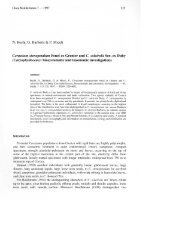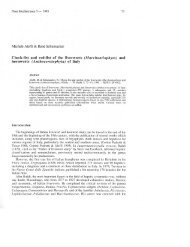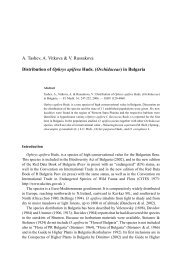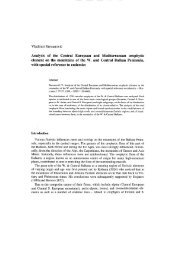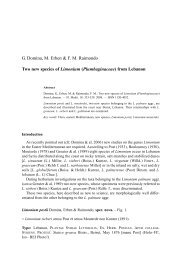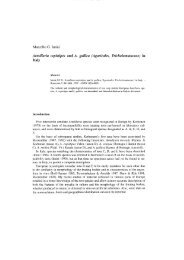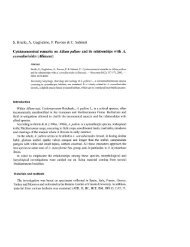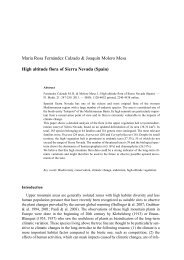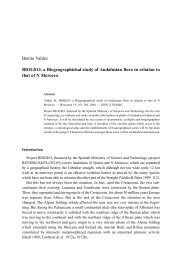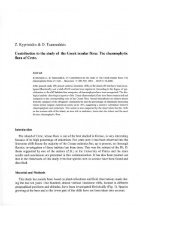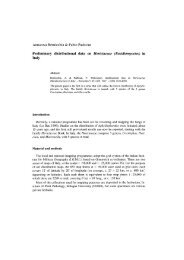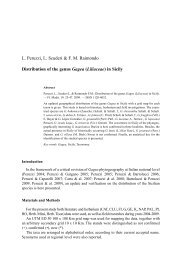Christoph Oberprieler The Systematics of Anthemis L. - Herbmedit.org
Christoph Oberprieler The Systematics of Anthemis L. - Herbmedit.org
Christoph Oberprieler The Systematics of Anthemis L. - Herbmedit.org
Create successful ePaper yourself
Turn your PDF publications into a flip-book with our unique Google optimized e-Paper software.
8<br />
<strong>Oberprieler</strong>: <strong>Anthemis</strong> in N Africa<br />
P-DESF<br />
P-LA<br />
RNG<br />
SEV<br />
UPS-Burser<br />
Herb. Bayreuth<br />
Herb. Oberp~ieler<br />
Herb. Vogt<br />
Muséum National d'Histoire Naturelle - Laboratoire de<br />
Phanérogamie Paris (Herbarium R. L. Des fontaines)<br />
Muséum National d'Histoire Naturelle - Laboratoire de<br />
Phanérogamie Paris (Herbarium J. B. P. A. de Monet de<br />
Lamarck)<br />
University <strong>of</strong> Reading, School <strong>of</strong> Plant Sciences<br />
Departamento de Biologfa Vegetai y Ecologfa, Universidad de<br />
Sevilla<br />
Botanical Museum at Uppsala University (Herbarium 1. Burser;<br />
micr<strong>of</strong>iche)<br />
Universitiit Bayreuth, Lehrstuhl fiir Ptlanzengeographie<br />
private collection <strong>of</strong> Ch. <strong>Oberprieler</strong> (Jena)<br />
private collection <strong>of</strong> R. Vogt (Berlin)<br />
Specimens were exarnined with a stereo-microscope (Wild M5A), measurements being<br />
performed using the camera-lucida device to slot in a millimetric scale in the corresponding<br />
magnification.<br />
<strong>The</strong> description <strong>of</strong> taxa is based on measurements made on dried plants. <strong>The</strong> variation<br />
ranges cited cover the total observed variation exhibited by a particular taxon. Extreme<br />
values have been placed in parentheses, while mai n range values relate to the interval<br />
covered by the mean ± l standard deviation <strong>of</strong> a particular character distribution.<br />
A list <strong>of</strong> specimens seen is presented under each species. Localities are given countrywise<br />
from W to E in the following order: Spain (N African part), Marocco, Algeria, Tunisia,<br />
and Libya. Within each country, administrative districts (Morocco: Province; Algeria:<br />
Wilaya; Tunisia: Gouvernorat; Libya: Baladiyah) are listed in alphabetic order. Within<br />
each district, specimens are listed from N to S. Most <strong>of</strong> the specimens are given with longitude<br />
and latitude <strong>of</strong> the collecting locality, written as stated by the collector(s), or taken<br />
from various maps [when they are cited in square brackets]. Distribution maps were drawn<br />
using the public domain map projection program MICROCAM by S. A. Loomer (ftp://ftp.<br />
usma.edulg&ene/gsl/microcarn/).<br />
For comparative carpological studies, achenes were taken from herbarium specimens<br />
and soaked for two days in a mixture (6 : l) <strong>of</strong> lO % aqueous solution <strong>of</strong> dioctyl sodium<br />
sulfosuccinate and 96 % ethanol (Peterson & al. 1978). Following dehydration through a<br />
l: 1,3: 7, l : 9 incrementai series <strong>of</strong> sulfosuccinate/ethanol, with changes every 24 hours,<br />
and a final step in pure 96 % ethanol for 45 min, achenes were subsequently soaked for 4-<br />
6 weeks in a pretreatment solution <strong>of</strong> Kulzer Technovit 7100® and solidifier no. 1 at 4°C.<br />
After final embedding in a l : 15 mixture <strong>of</strong> the pretreatment solution and Kulzer solidifier<br />
no. 2, median-transverse and median-Iongitudinal sections <strong>of</strong> achenes were made using a<br />
rotary microtome. 3-5 flm thick sections from the middle half <strong>of</strong> the achenes were stained<br />
with toluidine blue and mounted in Vitroclud (Langenbrinck).<br />
For scanning electron microscopy (SEM) achenes were taken from herbarium specimens,<br />
mounted on preparation stubs, and coated with a gold-palladium layer 2 nm thick in<br />
a Polaron sputter-coater. <strong>The</strong> observations and photography were performed with a Philips<br />
SEM 515 at the Botanical Museum Berlin-Dahlem.



